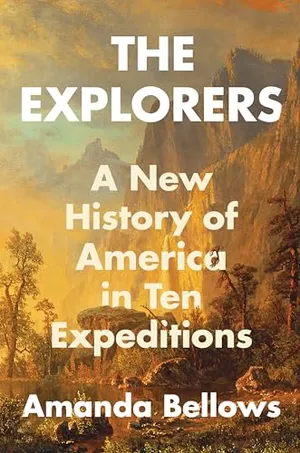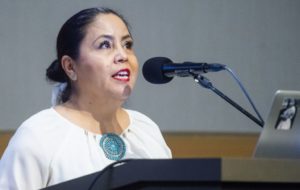Esteban, York and James Beckwourth charted the American frontier between the 16th and 19th centuries
Every summer, millions of Americans flock to the United States’ 63 national parks. Federally protected wilderness areas offer people the chance to explore a wide variety of terrain, from the vibrant canyons of the Southwest to the imposing mountains of the West Coast. Today, these public lands often represent an escape for Americans, 81 percent of whom live in cities. Some may agree with the naturalist John Muir, who believed that “wildness is a necessity” and national parks are “fountains of life.”
When Americans walk through dense forests or descend into gloomy caverns, they might recall explorers of the past who trekked across the country decades before Congress established Yellowstone as the U.S.’s first national park in 1872. Names like Daniel Boone, Davy Crockett and Kit Carson loom large in the popular imagination. But their stories are not the only ones.

For too long, the public and scholars alike have overlooked American adventurers from diverse backgrounds whose discoveries shaped the nation’s history. The time has come to fully recover their stories and acknowledge their important contributions. Doing so will not only correct the historical record but also support contemporary efforts to welcome people of color in national parks. According to National Park Service (NPS) data, 77 percent of park visitors are white, while just 23 percent are racial minorities. (People of color make up around 44 percent of the U.S.’s population.)
From the earliest days of European settlement, when an estimated 5 million to 15 million Indigenous people populated the lands that would one day form the U.S., people of color have been at the forefront of exploration. In 1527, an enslaved African man named Esteban reached North America as part of a Spanish expedition led by the conquistador Pánfilo de Narváez. After stopping on the islands of Hispaniola and Cuba, Narváez and his men landed in present-day Florida to search for gold. They soon became enfeebled by disease, and many perished. Native Americans drove those who survived, including Esteban, to the coast, where they set sail for the Gulf of Mexico.
During the years that followed, Esteban explored present-day Texas, Arizona, New Mexico and northwestern Mexico. He learned several Indigenous languages and even served as an interpreter. Esteban was, in the words of biographer Dennis Herrick, “the first person from the Old World of Europe, Africa and Asia to travel across the North American continent and also explore the American Southwest in the 1500s.” Although the circumstances of his death remain mysterious, he most likely perished in the Zuni village of Hawikku in New Mexico in 1539.
Over the next two centuries, Spain, France, the Netherlands and Great Britain competed to colonize North America. European settlers seeking economic opportunity arrived by the thousands. Displacing Native Americans from their homelands, they established farms or plantations, built towns, and raised families. Slave traders also forced enslaved Africans onto ships bound for North America, where slaveholders compelled them to work the land. Settlers carried viral diseases like smallpox and measles that decimated Indigenous populations. By the time the U.S. declared its independence from Great Britain in 1776, just four million Native Americans remained.
Two decades after the Revolutionary War ended in 1783, much remained unknown about the continent’s Western interior. By 1800, around five millionAmericans lived in the country, but most were concentrated on the East Coast.
On May 21, 1804, 45 men led by Meriwether Lewis and William Clark departed from St. Charles, Missouri, on a two-year journey across North America. Hoping to find a water route to the Pacific Ocean, the Corps of Discovery also sought to gather information about the geography, climate, wildlife and Indigenous peoples of the continent. The group’s mission was funded by Congress and supported by President Thomas Jefferson, who had just facilitated the acquisition of Louisiana Territory in 1803.
/https://tf-cmsv2-smithsonianmag-media.s3.amazonaws.com/filer_public/e3/f0/e3f05ecf-52e9-4612-8eac-66efef28c226/lewis_and_clark_at_three_forks_by_edgar_s_paxson_1912.jpg)
York, an African American man enslaved by Clark, played an integral role as the only Black member of the corps. An experienced frontiersman, York knew how to forage for edible plants and hunt wild game. Although most enslaved African Americans were forbidden to possess guns at the time, York wielded a firearm throughout his journey. He killed bison and geese, providing sustenance for the entire group.
York also provided medical aid to those suffering from illness. Stricken with what was likely a gastrointestinal infection, Sergeant Charles Floyd became incapacitated just months into the journey. It was York, principally, who tried to revive him, Clark wrote in his journal. When Sacagawea, the Shoshone woman who played a critical role as an interpreter and navigator for the corps, fell ill at Fort Mandan, York gave her stewed fruit and tea at regular intervals.
After reaching the Pacific Ocean in November 1805, the corps prepared to establish a winter camp. When deciding where to build the fort, the group held a vote. It is striking that, in an era when African Americans and women were legally denied the franchise, York cast his ballot alongside the other members of corps, including Sacagawea. This moment may have been the earliest occurrence of an African American person and a woman voting in U.S. history.

The corps returned safely to Missouri in 1806. The expedition’s members confirmed that no simple water route across the country existed and retrieved information about at least 178 plants and 122 animals new to science. York was a changed man following his experiences on the frontier. He asked Clark to emancipate him, but the enslaver initially refused. York probably gained his freedom at some point between 1811 and 1815.
Another Black explorer, James Beckwourth, found freedom and opportunity on the Western frontier in the mid-19th century. Born into slavery in Virginia but liberated by his white father, Beckwourth wound up in St. Louis at the height of the fur trade. It was a time when trappers explored the Rocky Mountains in search of lucrative beaver, otter and fox pelts. As a young man, Beckwourth keenly felt the pull of the West. As he later said in his autobiography, he found himself “possessed with a strong desire to see the celebrated Rocky Mountains, and the great Western wilderness so much talked about.”
Two hundred years ago, in the autumn of 1824, Beckwourth set off on a fur trading expedition headed by the frontiersman William Ashley. In the Rocky Mountains, Beckwourth gained critical hunting and navigational skills that enabled him to survive in the wilderness. As time passed, he became a veritable mountain man. In the words of historian Elinor Wilson, Beckwourth and other mountaineers were “pathfinders”; their geographic knowledge of the Rocky Mountains would later aid the Corps of Topographical Engineers and the U.S. Army.
During the years that followed, Beckwourth stayed at the vanguard of exploration. Traveling through Colorado, Kansas and New Mexico, he evinced an entrepreneurial spirit as a trapper and a trader. He made scores of friends, including Sacagawea’s son, Jean Baptiste Charbonneau, and also some enemies due to his mercurial behavior.
Beckwourth had a knack for being in the right place at the right time. When the California Gold Rush began in 1848, forty-niners flocked to the future state from around the world. In 1849, Beckwourth hitched a ride on the California, the first steamship bound for San Francisco from New York, when it stopped for wood in Monterey. Although he never struck it rich as a prospector in the Mother Lode Country, Beckwourth made a profit selling goods to other miners.
While looking for gold, Beckwourth also found an unknown pass in the Sierra Nevada. He raised funds to construct, and worked to complete, a road suitable for migrants who subsequently crossed over it and headed west toward California’s American Valley. Today, a historical marker stands at Beckwourth Pass, acknowledging the explorer’s discovery of the lowest pass through these mountains.
/https://tf-cmsv2-smithsonianmag-media.s3.amazonaws.com/filer_public/b5/8a/b58a77e5-03de-44ae-aeed-3dd3512e496d/view_of_tutocanula_pass_yosemite_california_by_carleton_watkins.jpg)
Esteban, Beckwourth and York are just three of many African Americans who explored America in its nascent years. Their findings contributed to the opening of the frontier. White migrants from the east, formerly enslaved people and impoverished immigrants seeking upward mobility all headed west throughout the 1800s. Tragically, increased settlement also led to the violent displacement of Indigenous people, the further spread of deadly illnesses among Native American populations and environmental destruction.
The rise of the conservation movement in the second half of the 19th century led to the creation of America’s system of national parks, many of which were built on Indigenous homelands. Congress passed legislation establishing Yosemite National Park in 1890 and Mount Rainier National Park in 1899, with dozens more to follow. But during the Jim Crow era, African Americans were often refused entry to public spaces within parks or were discriminated against while there. The Interior Department officially desegregated national parks in 1945, but discriminatory practices continued into the civil rights era.
Today, endeavors to make wilderness areas more inclusive are ongoing. In June 2020, the NPS announced its commitment to “lead change and work against racism.” The nonprofit Outdoor Afro “reconnects Black people” to nature through “education, recreation and conservation,” while Black Girls Hike seeks to “inspire others who look like us to be comfortable outdoors,” as a Virginia branch of the organization notes on its website.
The NPS has also taken important steps toward co-managing federal lands with tribal nations. As Charles Sams III, the first tribally enrolled person to serve as the NPS’s director, said in a 2022 statement, the agency is “strengthening the role of tribal communities in federal land management, honoring tribal sovereignty and supporting the priorities of tribal nations.” Today, four national parks have co-management arrangements. In March, the NPS signed a memorandum of understanding giving the Yurok Tribe guardianship of the redwood groves at ‘O Rew in California.
The story of U.S. exploration is a complicated one, with moments of discovery and displacement alongside destruction and preservation. Learning lessons from the past, however, can help our country build a better future where Americans of all backgrounds are able to protect and enjoy its treasured landscapes.




